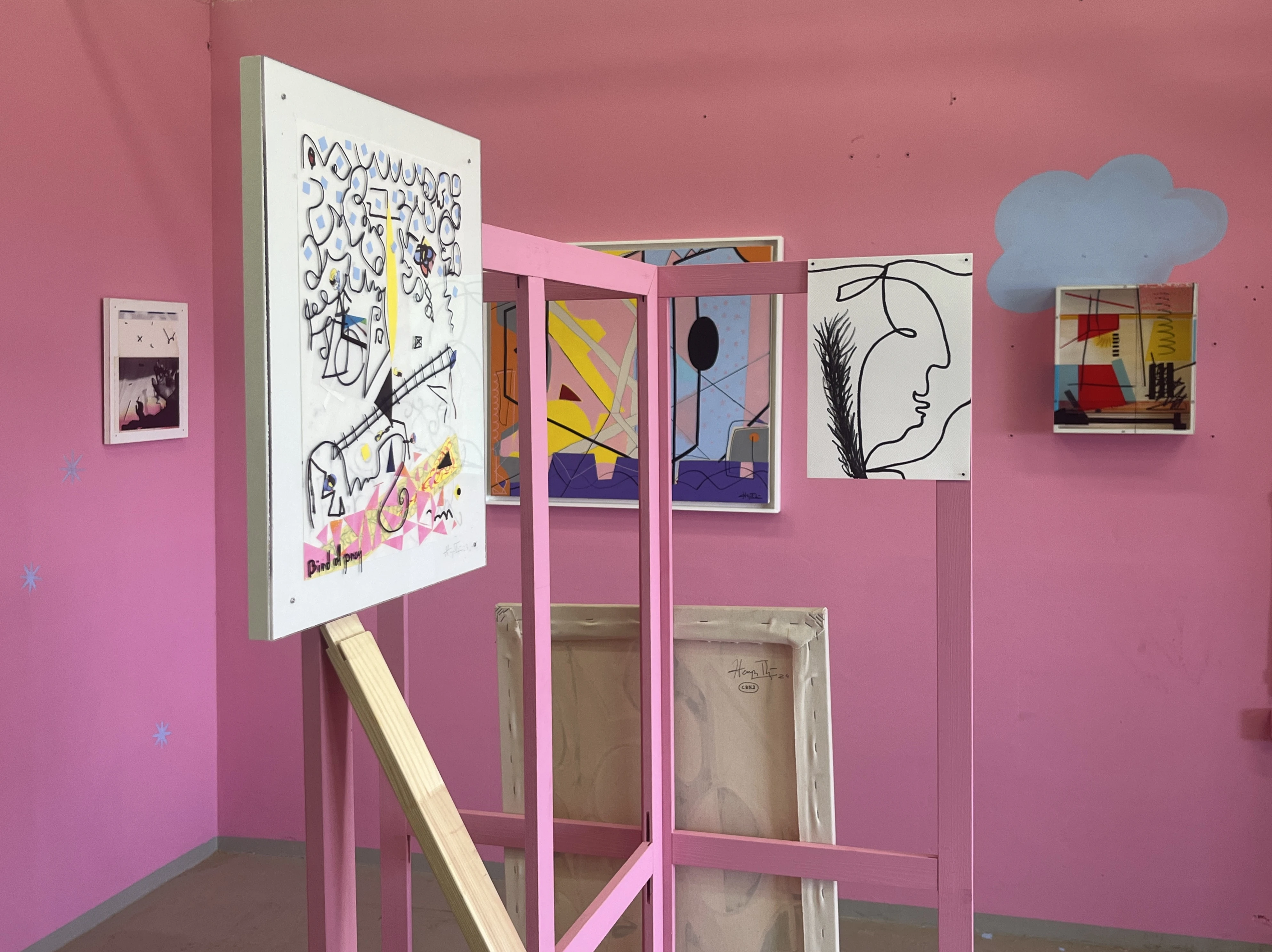
100, rue d`Abweiler
3211 Bettembourg
17. 07 - 10. 08. 2025

APERTURE
Thierry Harpes
Installation
A Space That Thinks Itself
With this installation, Thierry Harpes creates a visual system that doesn’t offer answers, but raises questions. Between pink walls, floating clouds, and exposed frameworks, a space emerges that not only looks back at us but reflects on itself — a site of display, doubt, and reversal. The “rose-tinted glasses” become a symbol of softened perception — a dreamworld, perhaps, or an illusion.
What does an image mean when it turns away? What happens to representation when its backside becomes visible? And what does a cloud say when it doesn’t drift by, but stays in place? Harpes invites us into a space of movement — across images, thoughts, and physical presence.
__________
Set in a pink-hued environment that feels like an inner archive of pop-cultural and emotional codes, the installation dissolves boundaries between image, object, and display. Instead of presenting finished works, Harpes creates a walk-in image-space — a fragile constellation of signs, fragments, and meanings. Nothing is final here; everything remains in a state of openness, potential, and becoming.
At the center stands a raw wooden structure, composed of stretcher bars and laths — partially supported, partially veiled. It recalls the hidden sides of paintings, moments of the studio, the unfinished behind the visible. As both display and commentary, it reflects what exhibitions usually conceal: the system that makes images visible.
This gesture echoes Brian O’Doherty’s critique of the so-called “white cube” — the institutional frame that pretends to disappear while exerting its strongest influence. In Harpes’ space, the structure is not neutral, but insists on its presence. It becomes what O’Doherty would call a "visual field with ideological content" — where framing is not background, but form-making force.
Hanging from this skeletal structure are individual works that differ in form, style, and material. Most striking is a line drawing of a face in profile, turning rightward — away from the center, toward something invisible. This subtle movement speaks of refusal, of openness, of shifting attention. Reduced to a minimum, the portrait becomes a site of projection — vulnerable, ambiguous, incomplete.
Blue clouds appear repeatedly across the pink walls. At first glance, they seem playful, even naive. But their recurrence charges them with symbolism: as signs of transience, as glitches in the system, as counter-images to architectural order. In the digital realm, the “cloud” has become a synonym for immaterial storage. Here, it becomes a floating metaphor for memory, possibility, and lightness.
The choice of pink is no coincidence. It disrupts the sterile neutrality of the white cube and creates an emotional, exaggerated atmosphere. This pink is not romantic, but constructed — as irony, as overstatement, as a balancing act between sincerity and performance. Within this chromatic tension, the images take on new layers of meaning: detached, theatrical, self-aware.
Thierry Harpes does not present a finished work, but an open tableau of possibilities. Every element — the skeletal frame, the turning face, the hovering cloud — is part of a larger mental image. These works demand not just to be seen, but physically and intellectually navigated: to be circled, approached, stepped away from.
Here, the image is no longer a static object. Following Hans Belting’s proposition, it becomes a relational event — one that unfolds between the image support, the visual content, and the viewer’s gaze. In this framework, the body of the viewer is not external to the image, but part of its activation.
This is not image as thing, but image in space — as process and as encounter. The space itself becomes an actor. Harpes invites us to rethink visuality not as surface, but as a relational system — between motif and support, line and volume, viewer and work. The focus is not the image as object, but image as action: an event that only emerges in the interplay of perception, context, and memory.
This installation is more than a statement about art. It holds a mirror to our visual culture in the digital age. Where everything is visible, Harpes asks: what do we really see? And what escapes our gaze?
